AWHI
ĀTIHAU-WHANGANUI INC. MAGAZINE
Tai-o-Rongo: Ngā tohu ki Tohunga
TOITŪ TE MANA
Mavis MullinsChanging the game
TOITŪ TE WHENUA
Te Paenga - a true Ātihau family affair
TOITŪ TE TANGATA
Te Āti Hau Trust associate trustee: Tukariri Dryden

HŌNGONGOI 2023
17
ISSUE
TOITŪ TE MANA
Incorporation
New
are
NGĀ PĀNUI
ĀTIHAU-WHANGANUI INCORPORATION ANNUAL GENERAL MEETING


Friday, 8 December 2023 Whanganui Racecourse
Full agenda and details will be included in the AGM Information Booklet, which will be sent in November.
TE
SCHOLARSHIP & GRANT APPLICATIONS
Thursday, 31 August 2023
Application forms online here: www.atihau.com/te-atihau-trust
A new body of
2 2
Contents
ĀTIHAU-WHANGANUI INC. MAGAZINE
ISSUE 17 / 2023
AWHI
8 THREE NEW MEMBERS JOIN ĀTIHAU GOVERNANCE TEAM
faces
bringing fresh perspectives and skills to the Ātihau board table.
14 TAI-O-RONGO: NGĀ TOHU KI TOHUNGA
research centred on Ātihau-Whanganui Incorporation land is unlocking the secrets of an ancient natural observatory.
FEATURE ARTICLE
ĀTI HAU TRUST
CLOSE
11 CHANGING THE GAME
How a keen eye for building strategic relationships changed the game for Ātihau.
6 STRATEGIC FRAMEWORK: RIGOROUS PROCESS TO DECIDE 10-YEAR STRATEGY
ready to finalise strategic intentions document.
TOITŪ TE WHENUA
20 TE PAENGA – A TRUE ĀTIHAU FAMILY AFFAIR
'We all pitch in and help each other out, depending on what needs to be done at the time.'
TOITŪ TE TANGATA
24
The Awhiwhenua cadetship programme will be reviewed to ensure it is fit for the future.
25
Shareholder tours offer insight into the business of farming and a closer connection to the whenua.


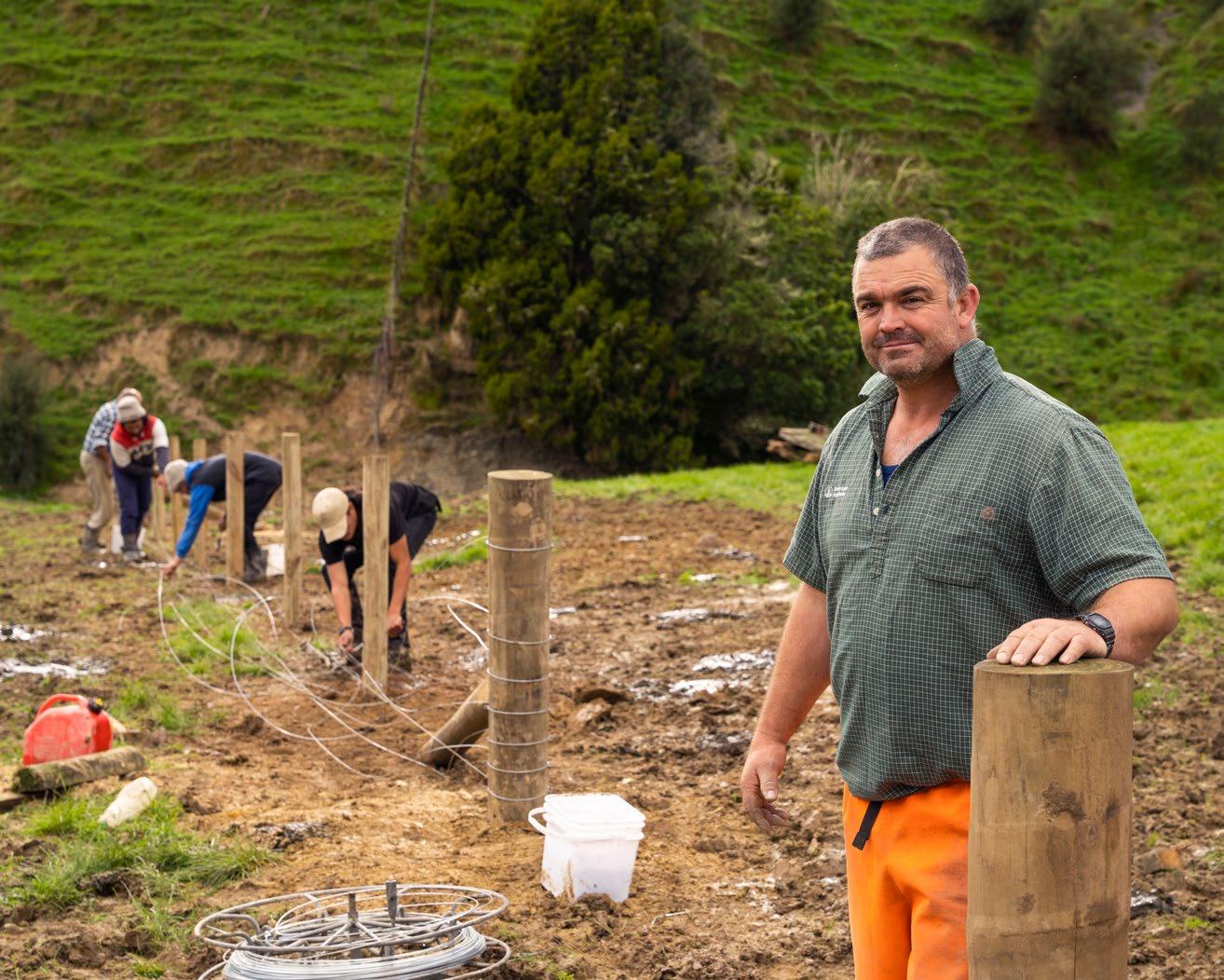
28
Tukariri Dryden on becoming Te Āti Hau Trust's first associate trustee.
31 IN GOOD HANDS
From past to present, Te Āti Hau Trust is in good hands and good health.

32
Why Rhys Mohi is taking on a Master of Māori Indigenous Leadership.
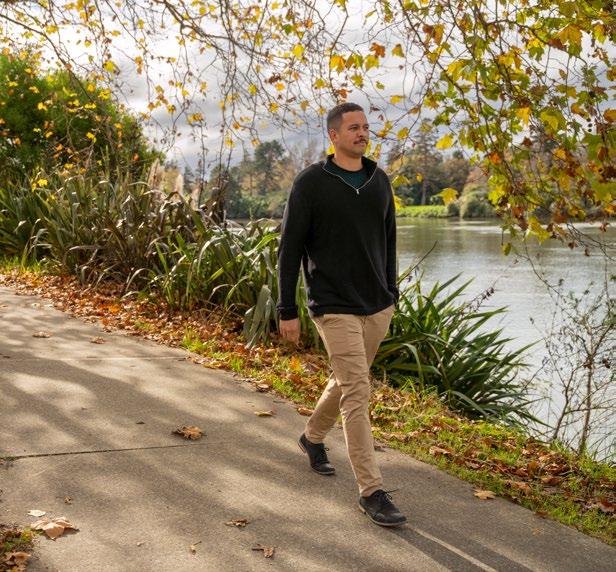
3 3
AWHIWHENUA FOR THE FUTURE
BACK TO THE WHENUA: FARM TOURS OFFER SPECIAL INSIGHTS
STEPPING UP
TE ĀTI HAU TRUST ASSOCIATE TRUSTEE
AWHI MAGAZINE
Editor Te Tiwha Puketapu

Deputy Editor Moana Ellis
Creative Director Sheree Anaru
Photography Quentin Bedwell
Graphic Design Cherie Quin
Illustration Dez Dromgool
ĀTIHAU-WHANGANUI INCORPORATION
Postal PO Box 4035
Whanganui 4541
Physical 35 Drews Avenue
Whanganui 4500
Ohakune 22 Ayr Street
Ohakune 4625

Telephone +64 (6) 348 7213
Fax +64 (6) 348 7482
Email office@atihau.com www.atihau.com
iSTUDIOS MULTIMEDIA LTD
Postal PO Box 8383
New Plymouth 4340
Physical 77B Devon Street East
New Plymouth 4310
Telephone +64 (6) 758 1863
Email info@istudios.co.nz www.istudios.co.nz
COVER PHOTO
Editor’s Pānui
Maramataka researcher and practitioner Meretini
Bennett-Huxtable, visits the ancient natural observatory at Tohunga Station.
CONTRIBUTORS
Polly Catlin-Maybury
Moana Ellis
Virginia Winder
Kua tata te mutu tēnei tau maramataka tā te ao tūroa i homai. Kua pahure te iti me te rahi o ngā tini mate. Kua wehe rātou, kua hoki wairua ki te wāhi ngaro, kia honoa ai ki ngā whetū i te rangi.
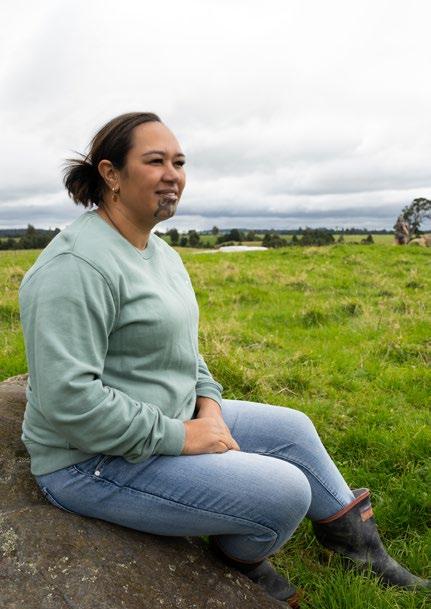
Haere koutou e ngā tini aituā i turakina ai i te wā makariri. Oti atu te pō, nau mai te ao.
Ka hoki mai ki a tātou, ko te mōrehu tāngata e piri whakapapa ai ki te mōrehu whenua, tēnā tātou katoa.
4
HŌNGONGOI 2023 ISSUE 17 AWHI ĀTIHAU-WHANGANUI INC. MAGAZINE Tai-o-Rongo: Ngā tohu ki Tohunga TOITŪ TE WHENUA Te Paenga – a true Ātihau family affair TOITŪ TE TANGATA Te Āti Hau Trust associate trustee: Tukariri Dryden TOITŪ TE MANA Mavis MullinsChanging the game
4
As the final touches are made to this winter edition of Awhi Magazine, our Tau Māori draws to a close. We attune ourselves to the changes of the season, prepare for the bite of Tāwhirimātea, and look forward to the beauty of the frost and ice on our whenua.
This is the time we turn our gaze to the early morning sky, scanning for signs of the return of Puanga and Matariki. Before we welcome our Tau Hou, this is our time to remember those we have lost, to reflect on their influence and impact on our lives, and the legacy they have left us.

As iwi and hapū of the mountain and the rivers, we have deeply felt the passing in recent times of some of our most beloved taonga, including kuia and koroua who
committed their lives to caring for and honouring our whenua, rivers and people, and who in this way embodied values this Incorporation holds close.
There is beauty, too, in our capacity to look after one another during these times of sorrow and mamae. For the benefit of generations to come, as a people we must be deliberate about holding fast to these values, practices and memories of those who have gone before us.
It is with this in mind that I commend to you our publication Mā Te Nui Āti Tū, Mā Te Rahi Āti Hau, a booklet that remembers and honours our first 50 years. In three sections written by Che Wilson, Esther Tinirau and Utiku Potaka, the booklet shares stories, history and
insights into how our Incorporation came to be. It explores our connection to the whenua, and the leadership and legacy left by our old people ... reminding us of where we have come from and, therefore, what we must now look after.
On that point, your Board and executives have completed a major review of the Ātihau Group strategy. A draft document that sets out an approach to facing the challenges and opportunities of the next decade is being presented to shareholder whānau before our strategic intentions are finalised. We look forward to your whakaaro.
I hope you enjoy this edition and the gifts of the season.
E mihi ana ki koutou, ki tātou katoa, Brendon Te Tiwha Puketapu
“This is the time we turn our gaze to the early morning sky, scanning for signs of the return of Puanga and Matariki.“
5
Strategic framework: Rigorous process to decide 10-year strategy
Ātihau-Whanganui Incorporation has developed a draft document that sets out its strategic intentions for the next 10 years.

6 TOITŪ TE MANA
The Ātihau Group strategic intentions document, describing the combined intentions of Ātihau-Whanganui Incorporation and Te Āti Hau Trust, has been in development for two years and is now being finalised.
Chief executive Andrew Beijeman says strategy is carefully reviewed every three years.
“The strategy developed this time has been a couple of years in the making – it’s been a much more thorough process than in the past.”
The strategy has been developed by the Board and executive team. In a series of special strategy development sessions, Ātihau has also called on the knowledge and experience of a group of former key personnel. Known informally as the Mātua group, it includes former chair, general manager and operations manager Dana Blackburn, former Committee of Management member and farm supervisor Jim Edmonds, and former long-serving secretary Lex Moody.
“The executive team has worked really hard on it,” Andrew says. “It has been two years of work looking at and analysing a whole range of
“This refreshed strategy demonstrates our generation’s desire to contribute, with respect for our past, hope for our future and positive growth in our time.”
different options. It has involved a lot of looking backwards in order to look forward. It’s been a rigorous process and I think where we’ve got to will ensure the business is a lot more resilient in the future.
“Within the strategic intentions document, we remind ourselves about where we’ve come from and we share the aspirations of the Ati Hau Way, that is, the purpose and the values that guide our decisions and actions. We talk about what we will do and what that means for the next 10 years in terms of strategic priorities.”
Setting strategic intentions with an outlook that points toward the vital few priorities will address the challenges of the next decade, Andrew says.
“It’s about living within our means and implementing some of the work we’ve been figuring out for the past two years. It’s also about talking to shareholders about how to implement our Taiao strategy, land use change, farm development and our investment strategy (our SIPO, or statement of investment policy and objectives).”
Board chair Dr Tiwha Puketapu says Ātihau-Whanganui Incorporation
and Te Āti Hau Trust have a shared ambition of working together to achieve the collective aspirations of the Ātihau Group.
“The strategic intentions in the document outline who we are, why we are here, and our focus over the next 10 years,” Tiwha says. “They recognise the interdependence between whenua and the people. To prosper, we must first retain and then restore the whenua.
“This refreshed strategy demonstrates our generation’s desire to contribute, with respect for our past, hope for our future and positive growth in our time.”
Dr Tiwha Puketapu
“It has involved a lot of looking backwards in order to look forward. It’s been a rigorous process and I think where we’ve got to will ensure the business is a lot more resilient in the future.”
7 TOITŪ TE MANA
Andrew Beijeman
Three new members join Ātihau governance
team
New faces are bringing fresh perspectives and skills to the Ātihau board table.

8 TOITŪ TE MANA
The Ātihau-Whanganui Incorporation has welcomed three new members onto the Committee of Management – Sarah Bell, filling the seat recently vacated by Ātihau stalwart Mavis Mullins, and two associate directors, Charles Chadwick and Jason Ashford.
It is important to have the skills and knowledge we need around the Board table to make carefully considered governance decisions,” says Board chair Dr Tiwha Puketapu. “Sarah, Charles and Jason will all bring different perspectives, life experience and knowledge to the kōrero, which will enable us to collectively find the best way forward for the business and our shareholders and whānau.”
Te Ātihaunui-ā-Pāpārangi, Ngāti Rangi
Sarah is already part of the Ātihau whānau, serving as secretary of the Ātihau-Whanganui Farm SubCommittee since 2021, and sitting in an associate director seat on the Board in 2018/19.

She has worked in the agricultural sector for the past 15 years, farming sheep and beef with family on tūpuna lands at Rangiwaea. She currently facilitates greenhouse gas workshops for Beef and Lamb NZ. Sarah has a Bachelor of Science in Physical Geography and postgraduate qualifications in the
Charles Chadwick
Te Ātihaunui-ā-Pāpārangi, Ngāti Rangi
Finding solutions to overcoming challenges has been a key driver throughout Charles' working life, bolstered by his ability to build relationships and understand differing perspectives.
Currently working for the Ministry for the Environment within the Te Mana o Te Wai team, ensuring that mana whenua are part of the decision-making process at regional council level, Charles previously delivered te ao Māori advice on policy, engagement,

management of effluent, sustainable nutrient use, and greenhouse gas emissions.
She is the deputy chair for the Ngāti Rangi boards Te Tōtarahoe o Paerangi and Ngā Waihua o Paerangi.
Passionate about the Incorporation, Sarah feels her skills are ideally matched to facing the environmental challenges the sector is up against while ensuring Ātihau farms maintain profitability, enabling the organisation to care for both te taiao and whānau.
strategy and leadership to central government as a consultant with Te Amokura.
He also has considerable experience in the social enterprise and NGO space, helping others to set up successful businesses. This has honed his skills in marketing, budget forecasting and analysis, and strategic decision-making.
Charles holds an MBA from Victoria University Wellington.
>>
Sarah Bell
9 TOITŪ TE MANA
“Sarah, Charles and Jason will all bring different perspectives, life experience and knowledge to the kōrero, which will enable us to collectively find the best way forward for the business and our shareholders and whānau.”
 Dr Tiwha Puketapu
Dr Tiwha Puketapu
After 18 years in the kaimoana industry, Jason brings considerable experience in leveraging revenue streams and opening doors to new markets.
Currently international sales manager for Moana Pacific Fisheries, he is exporting live oysters to China, Russia, USA and the Pacific in ever increasing numbers. He has also led a number of project teams in bringing new
products to the marketplace (especially China), with considerable success.
Married with two teenaged children, Jason was also a trustee for Te Whiringa Muka Trust (Whanganui iwi) and a director for Whanganui Iwi Fisheries Ltd.
Never far from the sea, he lists surfing and waka ama as his hobbies, as well as eating!
 Jason Ashford
Te Ātihaunui-ā-Pāpārangi, Te Arawa, Ngāti Tūwharetoa
Jason Ashford
Te Ātihaunui-ā-Pāpārangi, Te Arawa, Ngāti Tūwharetoa
10 TOITŪ TE MANA
From left: Charles Chadwick, Sarah Bell and Jason Ashford
Changing the game
How a keen eye for building strategic relationships changed the game for Ātihau. >>

11 TOITŪ TE MANA
Entrepreneurial spirit, strategic vision and a unique mix of operational and governance expertise – according to Ātihau-Whanganui Incorporation relationship partners, these are just some of the strengths former chair Mavis Mullins brought to the table.


The long-serving chair stepped down from the chairmanship and the Committee of Management last year in order to create space for growth and succession.
The first wahine to chair Ātihau ushered in a new era of diversification to spread risk and strengthen resilience, enabling the Incorporation to earn income from a diversity of business activities as well as sheep and beef. She also focused on the importance of strategic alliances, connecting the Incorporation to a wide range of people and organisations, skills, expertise, markets and opportunities.

Te Rūnanga o Ngā Wairiki Ngāti Apa chair Pahia Turia says her operational and Māori governance expertise

brought a strategic focus to the Te Hou Farm joint venture. When the iwi went into negotiations with the Crown to buy back Flock House Farm, the price was beyond them.
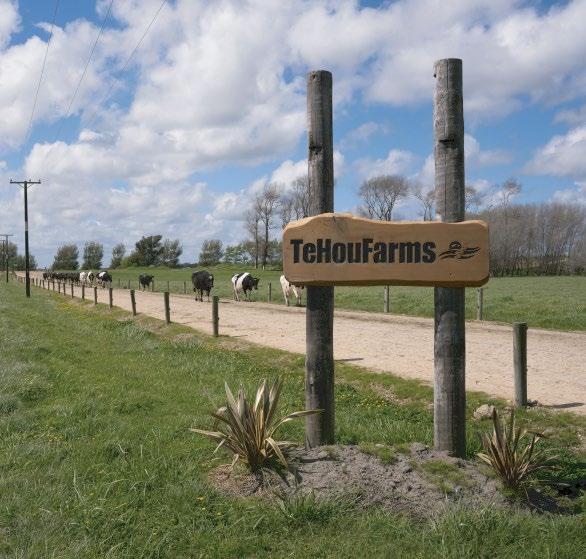
“We looked for partners and had a conversation with Mavis and Che [Wilson] about whether Ātihau would partner with us. That’s where the working relationship began.”
The initial partnership to purchase what is now Te Hou Farm was the iwi, Ātihau, and farmers Hew and Roger Dalrymple.
“Having that extensive farming experience sitting around the table has been massive. We as an iwi needed that to support the development programme we’ve undertaken on the farm.”
The Dalrymples exited several years ago. A two-way partnership remains between Ngā Wairiki Ngāti Apa and Ātihau.
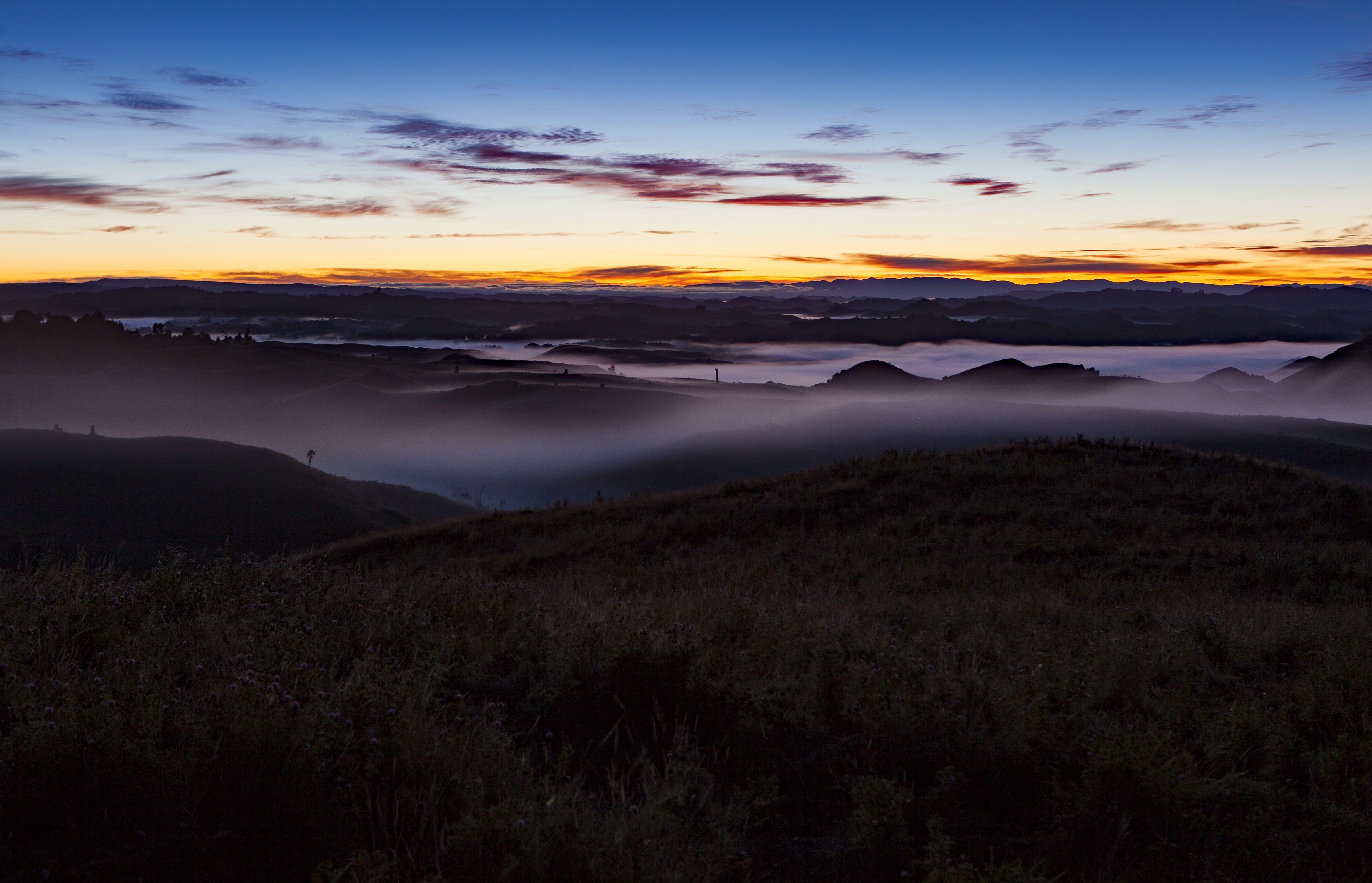
“It has been huge for us to have the expertise of Ātihau to support us in an operational capacity and also from a governance perspective. Mavis has a skill set that is not easily found. She brought to the table significant industry knowledge,
being a farmer herself and being quite heavily involved in the primary sectors.
“I want to thank her and wish her all the very best from our iwi for the huge contribution she’s made to our iwi, supporting us to become farmers once again. We’d been divorced from our lands for over 100 years, so we needed to make sure we got this right and had the right people at the table. Mavis was a huge part of that, right from first conversation. She saw it not only as an investment opportunity but a chance to build relationships and connections.
“It wouldn’t have happened without them, that’s how significant it was for us as an iwi. We’ll always be hugely indebted to them for that, always.”
In the United States, Ātihau formed another strategic partnership, this time with specialist distribution company Broadleaf, which supplies high-quality meat to wholesalers across America. From his base in Los Angeles, owner Mark Mitchell said Broadleaf connected with Ātihau through Mavis about nine years ago.
12 TOITŪ TE MANA
“I’m from near Alexandra in Central Otago – I worked for a shearing contractor in my teens. When we met in Los Angeles, we realised we knew each other when we were younger. As soon as we realised we had those connections, we got on like a house on fire.

“It really is all about relationships. Mavis has a really good understanding of people and especially country folk and farmers. She knows how it all comes together, from the time the product leaves the farm and goes to the processing plant to when it goes offshore to an importer and a manufacturer and a marketer. She understands what everyone does and what our challenges are, so it all fell into place. We started selling Ātihau beef and lamb.
“It was an easy relationship. Because of that, nothing was a problem, we just fixed it.”
Broadleaf supplies Ātihau products mostly to fine-dining hotels and restaurants. Every few years, the company brings four or five of its best customers to New Zealand for insight into where the product comes from.


“They get an appreciation of how it’s not just about the sheep and the cattle, it’s the people and the land – and at the end, you have a very special quality product.”
Former chair of Parininihi ki Waitōtara, Hinerangi RaumatiTu’ua, says the two women shared information and explored working together.


“Everyone looks for potential partners, everyone looks at what other entities are doing in order to figure out what you could be doing.
“We were both chairs of similar and like-minded incorporations focused on similar developmental paths. There were also similarities and connections between the shareholders, as well as some overlap.”
Hinerangi says Mavis brings an entrepreneur’s spirit to what she does.
“She is seen as a person with a commercial lens and an experienced governor.”
Current Ātihau chair Dr Tiwha Puketapu says his predecessor broke new ground.
“She changed the game for us around governance – skill, knowledge and experience now lines hard up against inheritance, and inheritance alone is not sufficient.
“She was our first woman chair – to be breaking glass ceilings is not a small thing. It is important for our daughters and nieces to know there are other ways to do things now.
“And, at the same time, Mavis concentrated our focus on those things that are most important to us – looking after our land and providing for our people.”
found.
brought to the table significant industry knowledge, being a farmer herself and being quite heavily involved in the primary sectors.”
“Mavis has a skill set that is not easily
She
13 TOITŪ TE MANA
Pahia Turia
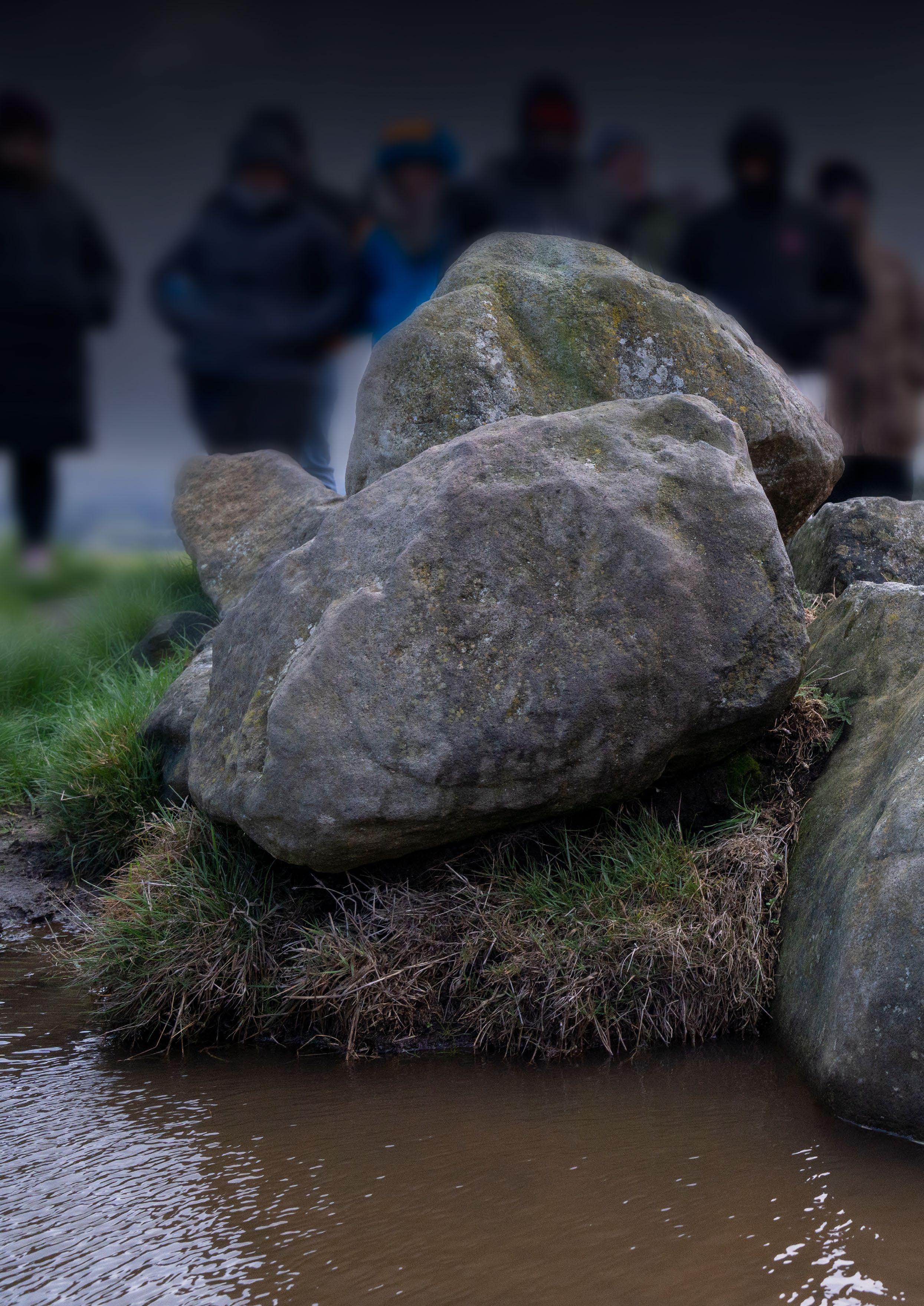
TOITŪ TE MANA 14
Tai-o-Rongo: Ngā tohu ki Tohunga
High on a wind-swept hill, ancestral knowledge systems and practices are being remembered. The tūpuna science connected with this ancient star-gazing site has been practised for generations and handed down to only a few, but a new kaupapa is working to re-connect whānau whānui with the natural world. Moana Ellis reports.

>> 15 TOITŪ TE MANA
Ātihau-Whanganui Incorporation board director Che Wilson stands on a broad, flat-topped hill at the top of one of our stations. A herd of black cattle have inched their way to the fence, curious about the scores of shareholder whānau gathered to hear some of the secrets of this sacred site at Tohunga Station.
It is an ancient observation point and a natural observatory – a place of learning and ritual practices – offering unfettered views of the mountains and hills in every direction and opening up the night sky for astronomy.

It is a site being used today to revive traditional weather observation and prediction.
“This place is called Tohunga because of the tohu you can get from here,” Che says.
He also reveals a sophisticated complex of tūāhu (rocks) including “a star constellation in the ground” aligned with Māhutonga (the Southern Cross).
“There’s a whole landscape of special stones here. This is our version of Stonehenge. The role of these rocks is to help us to read the weather and make predictions for the season and the year ahead.”
Alongside Te Wiwini o Rongo, a tūāhu of thanksgiving for cultivated food, are tūāhu serving as guardians of the winds, a waiwhetu (reflection pool), pointer stones to Māhutonga, the in-ground constellation itself, and a series of cultivation terraces and food pits. The tūāhu have names such as Hinemarangai, Ohineari, Ranginui, Rangiroa, Kupu-ahi, Pua-ahi, Pauahi, Neha (also known as Newha) and Kautū-ki-te-rangi.
“The names are codes to our science,” Che says. “They’re also codes to our spirituality, all wrapped up in one.”
The existence of the complex has been “deliberately kept quiet” to protect it from western archaeology practices and to preserve the mātauranga for future generations.
Now, Che believes the time is right to share this kōrero tuku iho more widely among whānau. He is leading Tai-o-Rongo, a wānanga and kaupapa Māori programme of research centred on the tūāhu at Tohunga and aimed at reviving the systems, practices and ceremonies linked to it.
“Tai-o-Rongo is helping to give recognition to places and practices that are extremely important and have been left out of attention’s way,” he says.
“It is a wānanga to revive traditional weather observation and weather prediction.
“We’ve had a number of our navigators who have navigated the Pacific up here to check the features on these horizons and they align with their teachings on the ocean.”
Tai-o-Rongo considers how uri can reconnect to and look after their whenua, and how to foster and revive the knowledge connected with it.
 Left: Board member and Tai-o-Rongo research principle Che Wilson reveals kōrero tuku iho about an ancient stargazing site at Tohunga Station.
Left: Board member and Tai-o-Rongo research principle Che Wilson reveals kōrero tuku iho about an ancient stargazing site at Tohunga Station.
“This is our version of Stonehenge. The role of these rocks is to help us to read the weather and make predictions for the season and the year ahead.”
16 TOITŪ TE MANA
Che Wilson
Pua-ahi, Pau-ahi, Neha, Kautū-ki-te-rangi
“The names are codes to our science.
“Some of the karakia talk about ‘kei te whakawiniwini te tai o te pō, kei te whakawanawana te tai o te ao’. That’s talking about the flow that’s part of creation and that is within us – invoking that tai, that flow, to enhance all our senses, our rongo, so that we are not just seeing and hearing, smelling and feeling, but we’re engaging our whole body to connect with te taiao.”
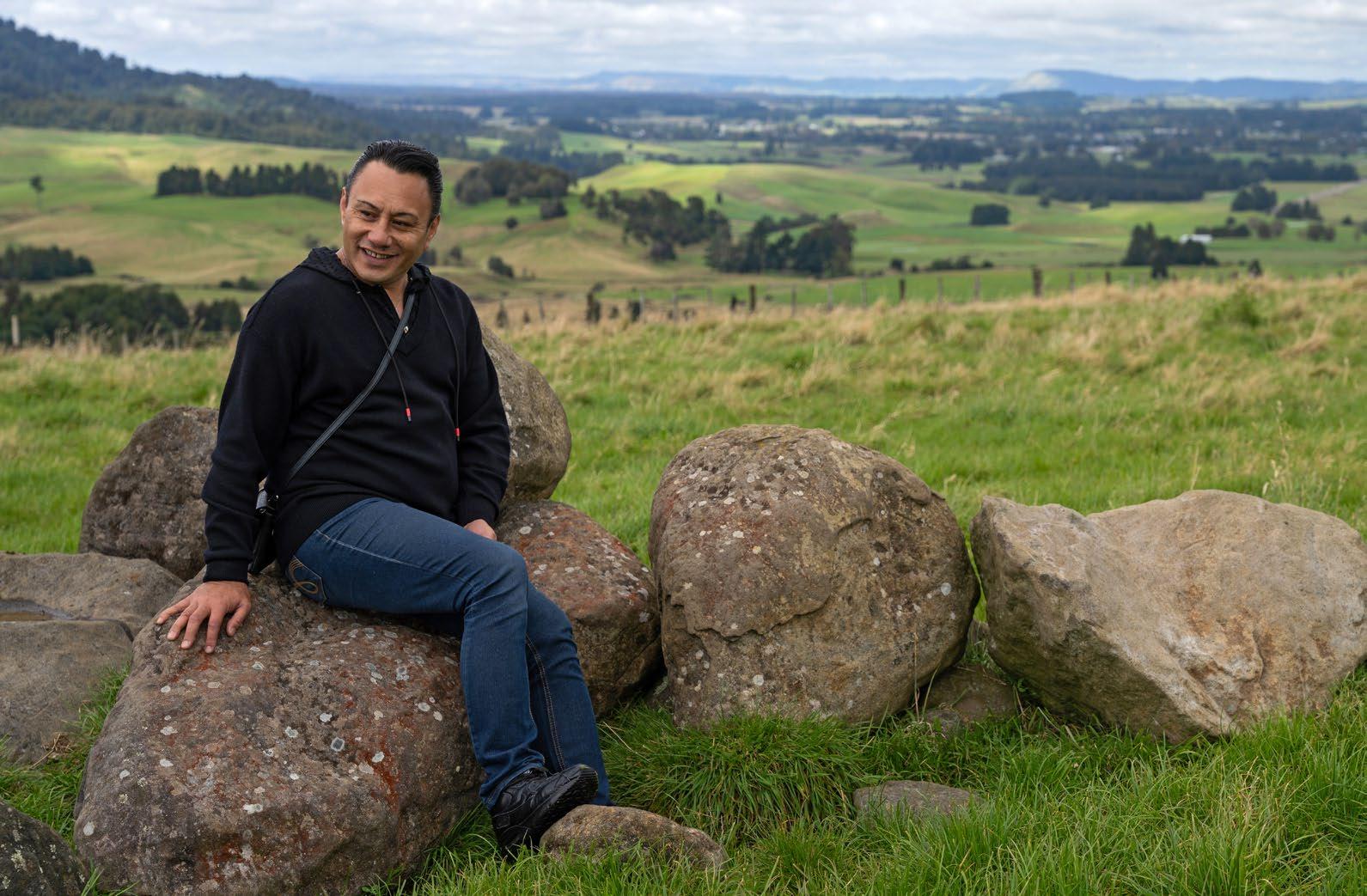

Che says the principle keepers of knowledge have been our kai gatherers. The research has focused on talking with those knowledge keepers, and asking the right questions.
Tai-o-Rongo is a National Science Challenge programme involving Ātihau-Whanganui Incorporation and iwi through NAIA Limited.
“I initially kept the group small and started off with a certain age group because I’m mindful that the age group above can often be fearful of change and doing things differently,” Che says. “The last thing you need is doubt when you’re exploring something that’s different to what we may have done in the past.
“We’ve got to a space now where we can start to open it up to encourage the growth. We need
 Che Wilson
Che Wilson
>>
Below: Shareholder whānau visit the ancient natural observatory at Tohunga Station and learn the names of the complex of tūāhu dedicated to the winds, the stars and thanksgiving for cultivated food.
They’re also codes to our spirituality, all wrapped up in one.”
Te Wiwini o Rongo, Māhutonga, Hinemarangai, Ohineari, Ranginui, Rangiroa, Kupu-ahi,
17 TOITŪ TE MANA
to be sharing more with ourselves. That’s going to be a challenge for some but we’ve got to open it up for those who wish to learn, because we’ve been bereft too long.
“There will still be some tohunga knowledge, but we need to be democratising a lot more.
“He wā anō ka hura ngā kura hunahuna, he wā anō ka mātau ki ērā kura hunahuna, he wā anō ka mārama ki ngā kura hei kura i te ao nei.”
The rōpū has grown to include practitioners in navigation, astronomy, gardening, hunting and gathering, carving and weaving, water science, geology and the maramataka.
Maramataka researcher and practitioner Meretini BennettHuxtable says Tai-o-Rongo will help people to re-engage with the practice of ceremony.
“We’re validating what our tūpuna already knew and that’s the most empowering part about it. We’re also engaging back in te taiao with the language that they remember, that the taiao remembers.”
“It will help inform and reinvigorate that relationship with the whenua and with our taiao, and the importance of that. Part of this is looking at how re-engaging with our kōrero tuku iho might help our farmers here in the central plateau region to make better-informed decisions on land.”

The research has included looking at how to apply this knowledge to the farms, in particular to help guide animal husbandry and planting.
Meretini has also been working with CEO Andrew Beijeman on how Atihau-Whanganui could incorporate the maramataka into a new framework for its business, operations and activities.
“Through the maramataka, we have the opportunity to look at the environment and make some forecasting to support farmers ahead of what might be coming. Tai-o-Rongo can take a scope of the land and give our feedback as a rōpū. You have 30 of us coming together to wānanga, bounce ideas around, understanding what the kōrero tuku iho is, and what waiata, what tātai, what karakia might be saying in response to some of those tohu that we’re seeing in different places ... and we can make a forecast.”
Meretini says re-engaging in ceremony will change how people interact with the whenua.
“It will help us as a people to engage with new waiata, new kōrero and new karakia that are in line with what we’re seeing and hearing in this day and age, as well as understanding what our tūpuna saw before us.

“Ceremony is really important for us and our kōrero with the whenua. What do we have to lose by going out and having a mihi to Papatūānuku or to the awa or to the maunga, and saying: this is what we’re doing, this is our intention, this is the reason we’re doing it.
“For me, that’s what ceremony means – purposeful intention in the work that we do, to ensure that the whenua understands what we’re doing so that it can respond in the same way.”
Right: Maramataka researcher and practitioner Meretini BennettHuxtable (with daughter Peyton Huxtable) and Che Wilson, sharing some of the features and practices of the star-gazing site at Tohunga Station.
“It will help inform and reinvigorate that relationship with the whenua and with our taiao, and the importance of that.“
18 TOITŪ TE MANA
Meretini Bennett-Huxtable


“Tai-o-Rongo is helping to give recognition to places and practices that are extremely important and have been left out of attention’s way.”
19 TOITŪ TE MANA
Che Wilson
Te Paenga – a true Ātihau family affair
The running of Te Paenga station is very much an Ātihau family affair – and it looks like it will continue that way for a long time.

TOITŪ TE WHENUA 20
Farm manager Sheldon O’Hagan has worked on ĀtihauWhanganui Incorporation farms for 21 years, starting as a shepherd on Omerei station, then moving on to Tawanui and Operiki before taking on the farm manager role at Te Paenga four years ago.

Wife Renee helps out with the farm admin when she isn’t taking care of people in her HR role at the Ātihau office in Whanganui, and eldest daughter Elizabeth works at the Hapuawhenua dairy farm when she isn’t studying for her Animal Science degree at Massey University. Middle daughter Josie is in Wellington, and youngest daughter Charlotte loves animals and is thinking about a future in farming.
The baby of the family is 15-year-old Sheldon, who is a chip off the block in more than just name.
“There’s only one way Sheldon is going to go, and that’s farming,” chuckles Sheldon senior. “He just wants to be out there doing it. He loves being out on the land and being hands-on with the stock.”
Sheldon himself didn’t come from a farming background (describing his parents as ‘townies’) but his mates were all farmers and he caught the bug from them.
“I have been very lucky in that I have had some great role models right from when I was starting out, which helped that passion grow,” he says. “I worked for nine years under Steve Tapa at Tawanui and he was really good at helping me to grow
my knowledge and confidence until I was ready to take on a farm manager role.”
Sheldon says he stayed with Ātihau throughout his career because it is a whānau-oriented business. “You can’t underestimate the importance of good people and a good working environment.”
The farm itself is a breeding operation covering 3,497 hectares of challenging hill country, of which 2,530 hectares are effective, with the rest a mix of native bush and mānuka under Ngā Whenua Rāhui kawenata.


>>
Left: Sheldon O'Hagan, farm manager at Te Paenga station. This page (top to bottom): Elizabeth and Charlotte O'Hagan. Sheldon O'Hagan with son, Sheldon. Josie O'Hagan.
“That’s what makes us such a good team. We all work together for the benefit of the animals and the farm.”
21 TOITŪ TE WHENUA
Sheldon O'Hagan
A breeding herd of 750 Angus cows produces upwards of 650 calves each year in early October, which stay with their mothers until late March/early April. Then they are weaned and drafted, with the steer calves heading straight to the Ātihau finishing farms. The heifer calves stay on farm and 200 are selected as replacements for the breeding mob.
“We have found this gives them the best start and we have quality animals right from the get go,” says Sheldon. “This season they are looking particularly good due to the exceptional grass growth we have been experiencing.”
Of course, genetics play a big role in the quality of a beast and the meat it produces, and Sheldon purchases his bulls from the Te Mania Angus bull stud in North Canterbury, along with the three other Ātihau breeding stations. Around 24 bulls go out to the girls, grouped by age, in late September.
“The bulls you use are allimportant, and these ones produce superior marbling in the meat, which is what gives it that amazing flavour,” says Sheldon. “And, as importantly, they have the physicality to cope with the hill country.”
Alongside the cattle, 10,500 ewes produce around 12,500 lambs each year, with lambing beginning in late August. Previously the flock has been all Perendale, but Sheldon has been introducing Romney rams to help bring higher-performing genetics into the breeding stock. “It always used to be Romneys up here, so you could say I’m taking the station back to its roots,” he says.
The largest lambs are weaned in late December and go off to the works, with the rest staying with their mothers until January shearing, drenching and weaning comes around. Again, the largest lambs go off to the works while
3,000 ewe lambs are kept as replacements and the rest go to Ohotu or Tohunga stations for finishing.
“Te Paenga was split to create a smaller block around five years ago so we could really focus on improving stock performance,” says Siwan Shaw, Ātihau Business Manager. “That focus is delivering some good results. Sheldon and his team have increased their monitoring and it is paying off.”

“Te Paenga was split to create a smaller block around five years ago so we could really focus on improving stock performance.”
22 TOITŪ TE WHENUA
Siwan Shaw
“There’s always something going on up here,” says Sheldon. “The animals and their welfare come first, and then there is always a list of farm work to tackle.” He credits his team of five as the ones behind the success of the station. “Like a shepherd is only as good as his dogs, a manager is only as good as his team and I have got a really great team with me here on Te Paenga.”
Head shepherd Jade Johnson and the newest member of the team Brayden Clement take care of the stock, helped by junior shepherd Damian Biddle, a second-year
Awhiwhenua cadet. Fencers Tamati Aramoana and Keith Cranston (another Ātihau stalwart with 18 years under his belt) make sure the animals stay where they are supposed to.
“But we all pitch in and help each other out, depending on what needs to be done at the time,” says Sheldon. “That’s what makes us such a good team. We all work together for the benefit of the animals and the farm.

“It’s a real privilege to work on this land, and its good sometimes when you are up in the hills to just stop and take a moment to appreciate it.”
Below: Sheldon O'Hagan is proud of the way his team pitches in and works together. From left are Tamati Aramoana, Keith Cranston, Damian Biddle, Jade Johnson and Sheldon O'Hagan.

“Like a shepherd is only as good as his dogs, a manager is only as good as his team and I have got a really great team with me here on Te Paenga.”
23 TOITŪ TE WHENUA
Sheldon O'Hagan
Awhiwhenua for the future
A review will soon be underway to ensure the Awhiwhenua cadetship programme is effective, meets its strategic purpose, and is fit for the future.
The programme consists of a three-year apprenticeship in sheep and beef farming, run in partnership with work-based training organisation, Primary ITO.

First-year students are accommodated in the purpose-built whare at Te Pā station, which is not only somewhere to sleep but also a place to learn life skills, and secondand third-year students are placed on Ātihau farms.
Currently there are three year 1 cadets, and one in year 2 (located at Te Paenga) and year 3 (located at Tawanui).
"Regular reviews are important to ensure the programme we are offering is both suitable for the rangatahi who come to learn and aligns with the strategic focus of the organisation," says Whetu Moataane, Manager Culture & Legacy for Ātihau-Whanganui Incorporation.
“There is the potential for expanding the programme to offer apprenticeships in apiculture and dairying, as well as taking
on more cadets, although we are constrained by the number of second and third placements we can provide at the moment.”
The three-year course aims to set cadets up for success in the agricultural industry. During the first year, 85% of course time is spent out on the whenua getting practical experience under the eye of farm manager Jim Doolan and Wesley Johnstone, with a weekly study group and monthly classes in Taihape. One-on-one sessions with a study co-ordinator make up the balance. At the conclusion of the course, cadets leave with a Level 3 New Zealand National Vocational Certificate in Agriculture.
“It is a comprehensive programme that enables these young people to be confident in their abilities and knowledge when it comes to finding a job once they have graduated,” says Whetu.
“It has also given us some other more wide-reaching outcomes such as enabling rangatahi and their whānau to reconnect with their whakapapa and the whenua.”
Two current cadets are a case in point. Although the two brothers come from the Whanganui awa area, they, along with their family, weren’t aware of their connections to the Ātihau whānau and are now starting on a journey to learn more.
“Reviews are important to ensure that the Awhiwhenua programme continues to deliver benefit to the tauira themselves, the Incorporation, and uri,” says Whetu. “We will provide an update once the review has been completed.”
”Regular reviews are important to ensure the programme we are offering is both suitable for the rangatahi who come to learn and aligns with the strategic focus of the organisation.”
Whetu Moataane
24 TOITŪ TE WHENUA
Back to the whenua: Farm tours offer special insights
Shareholder Farm Tours are a much-anticipated highlight of ĀtihauWhanganui Incorporation’s annual calendar. Valued by whānau as a chance to learn more about the whenua and the business, they include site visits to one or two of the Incorporation’s farms each year. >>
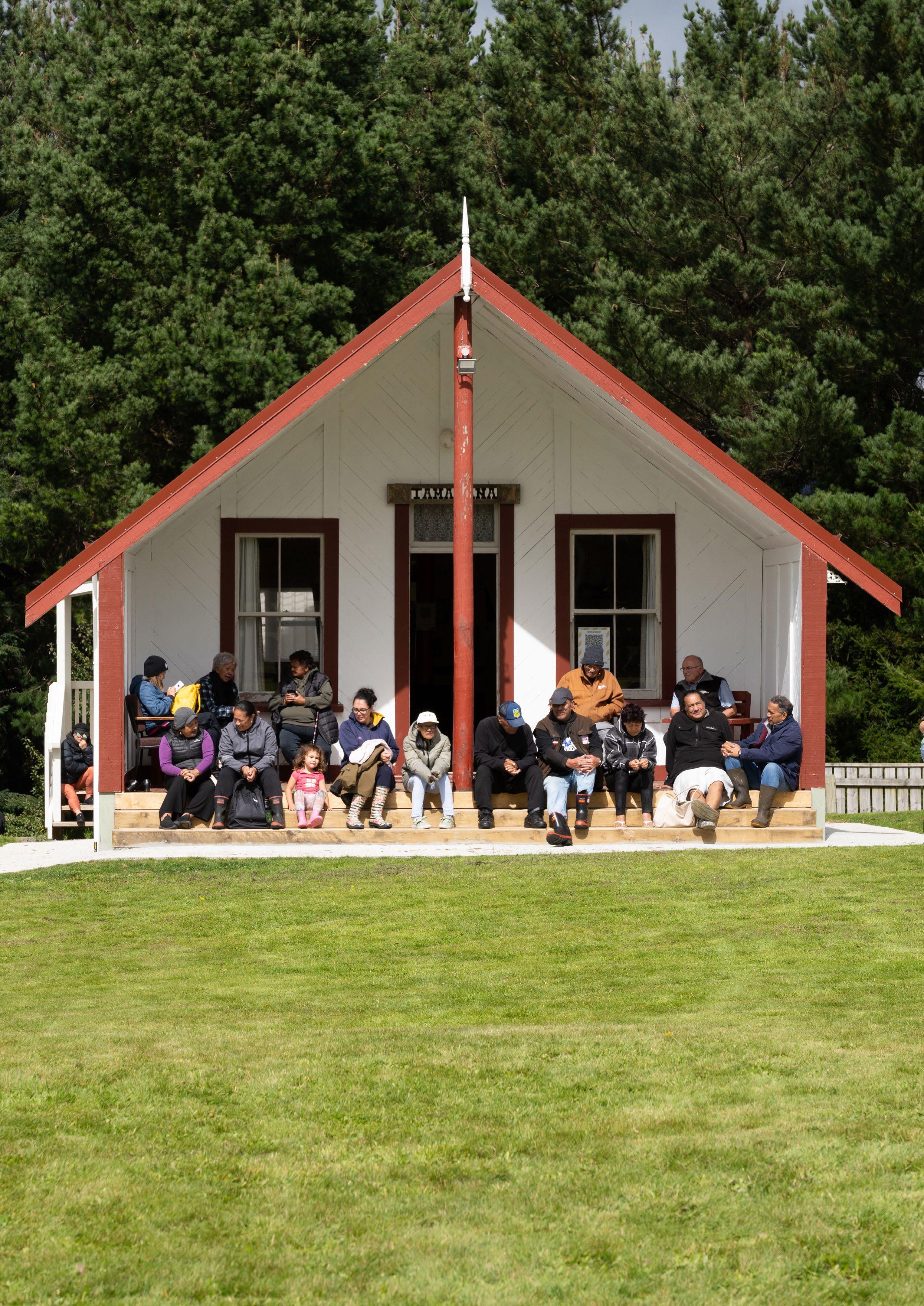
w
25 TOITŪ TE WHENUA
By walking the whenua and hearing from farm managers and senior staff on the ground, the tours give first-hand insight into farm operations and help whānau get to know the lay of the land.
Rain or shine, they are always a popular day out, with scores of whānau taking the opportunity to re-connect with their whenua, whakapapa, history and whanaunga.
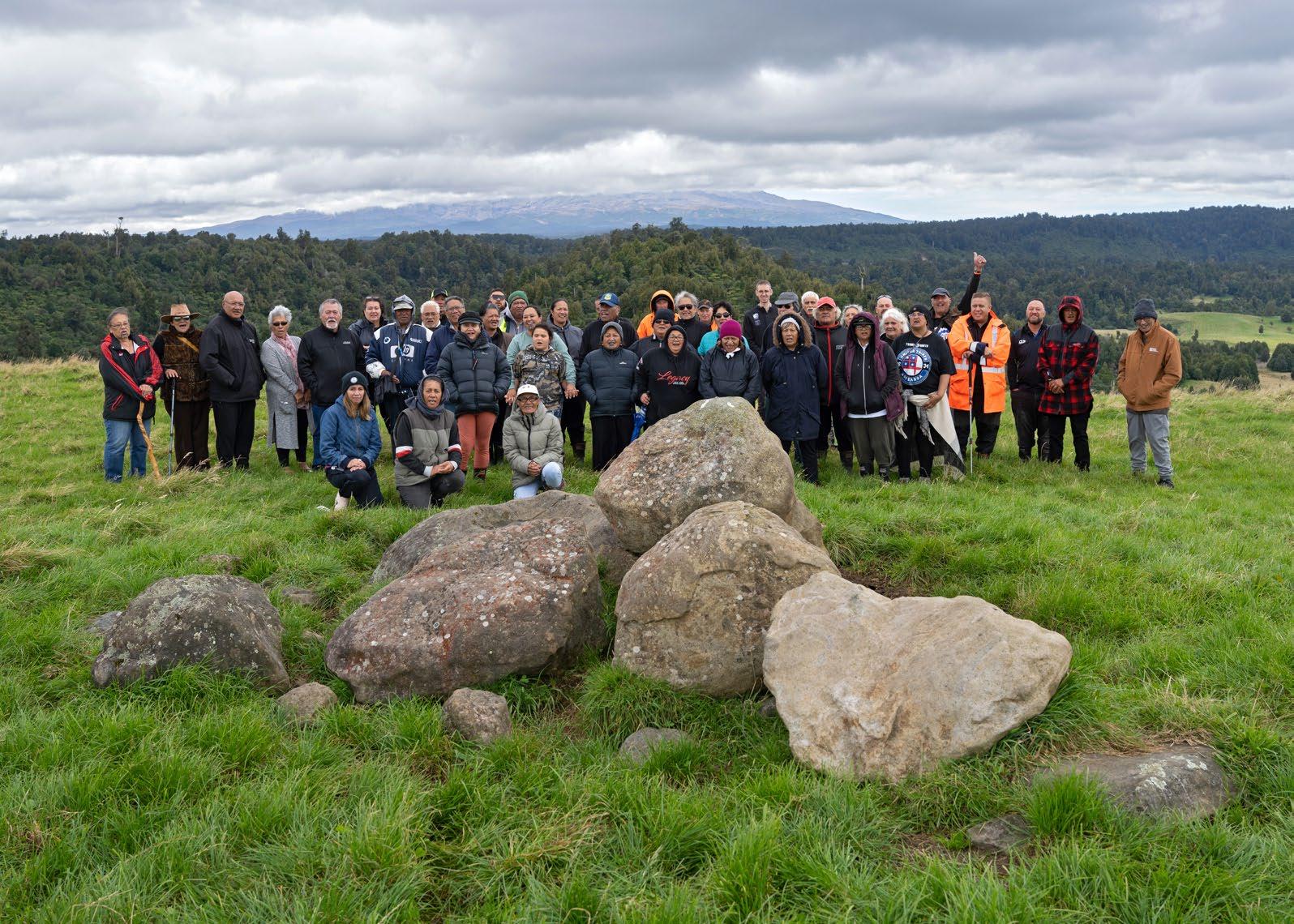
The Shareholder Farm Tour 2023, on a bright but chilly day at the end of March, was no exception, with visits to Hapuawhenua, the Incorporation’s only dairy farm, and Tohunga, one of its two finishing stations, both on the outskirts of Ohakune.
Hapuawhenua farm manager John Lynch introduced the 670-cow dairy unit, talked about the unique challenges of the long, narrow site and the difficulties of attracting staff, and showed shareholders through the 44-a-side herringbone milking shed.
At nearby Tohunga, farm manager Dean Francois outlined the operations of the 1100ha (900ha effective) farm. With 770 cattle sold up to the end of March and only 139 of the two-year-olds left to sell before the end of the financial year, the farm also has 9000 trading lambs on hand, having sold 4300 so far this season.
The Tohunga tour also had something special in store for shareholder whānau – an introduction to one of the most important ancient star-gazing sites of the takiwā. At the top of the station, Ātihau-Whanganui board director Che Wilson revealed an ancient natural observatory and a sacred place for ritual practices.
“This is Tohunga Station, called Tohunga because of the tohu you can get from here. This was traditionally a good place to read the weather and make predictions for the season and for the year,” Che told shareholders, pointing out and naming landmarks, orientation points and a cluster of tūāhu.
“This is our version of Stonehenge. We’re lucky that we’ve got some of our special places that are protected and under our ownership.”
Whetu Moataane, Manager Culture & Legacy, says Shareholder Farm Tours are about connection.
“They give whānau the chance to reconnect with the land and gain
an in-depth understanding of the workings of our individual farm operations. They can meet and talk directly to the people who look after their assets, and it’s a great day for strengthening whakapapa connections and spending time together as whānau.”
Allan Taurerewa says shareholder tours deliver the type of knowledge he has for decades hungered for.
“The kōrero that we had today, some of it was like an epiphany for me. Che’s kōrero up there [at Tōhunga] highlighted our worldview. It was also a reassurance that the journey I’m taking back into my own culture is bringing the fruits I was hoping it would bring –reconnection to my whānau, and
Right: Shareholder whānau visit the ancient natural observatory at Tohunga Station.
“They give whānau the chance to reconnect with the land and gain an indepth understanding of the workings of our individual farm operations.”
26 TOITŪ TE WHENUA
Whetu
Moataane
reconnection to the whenua and the many blocks that I have never put a footprint in.
“What I have received has nourished me. My journey in the later stages of my life is about being present on my own whenua, acknowledging my kaitiaki role that I must play. We have a responsibility to our whenua, to look after it and to ensure it’s here for our children in the future.”
Fiona Prince says the tours are a chance to walk again on the whenua she knew as a child. Her Nanny Mere Tapa and Koro Bob Tapa were frequent visitors to her childhood home at Tohunga Junction and were closely

connected to the special site at Tohunga.
“We grew up on a lot of these farms – my aunties and uncles managed some of them: Lou Tapa, Winiata Tapa and now my cousin Steve Tapa, who is on Tawanui. That’s what attracts me back here – going back on that journey in history and time, remembering and understanding where I belong.

“It’s now time to bring more of the younger generation home, get them involved and let them get a bit of understanding. When we have our next farm tour, I’d like to invite my daughter home. My dream is for her to one day come back to be a part of it all back here.”
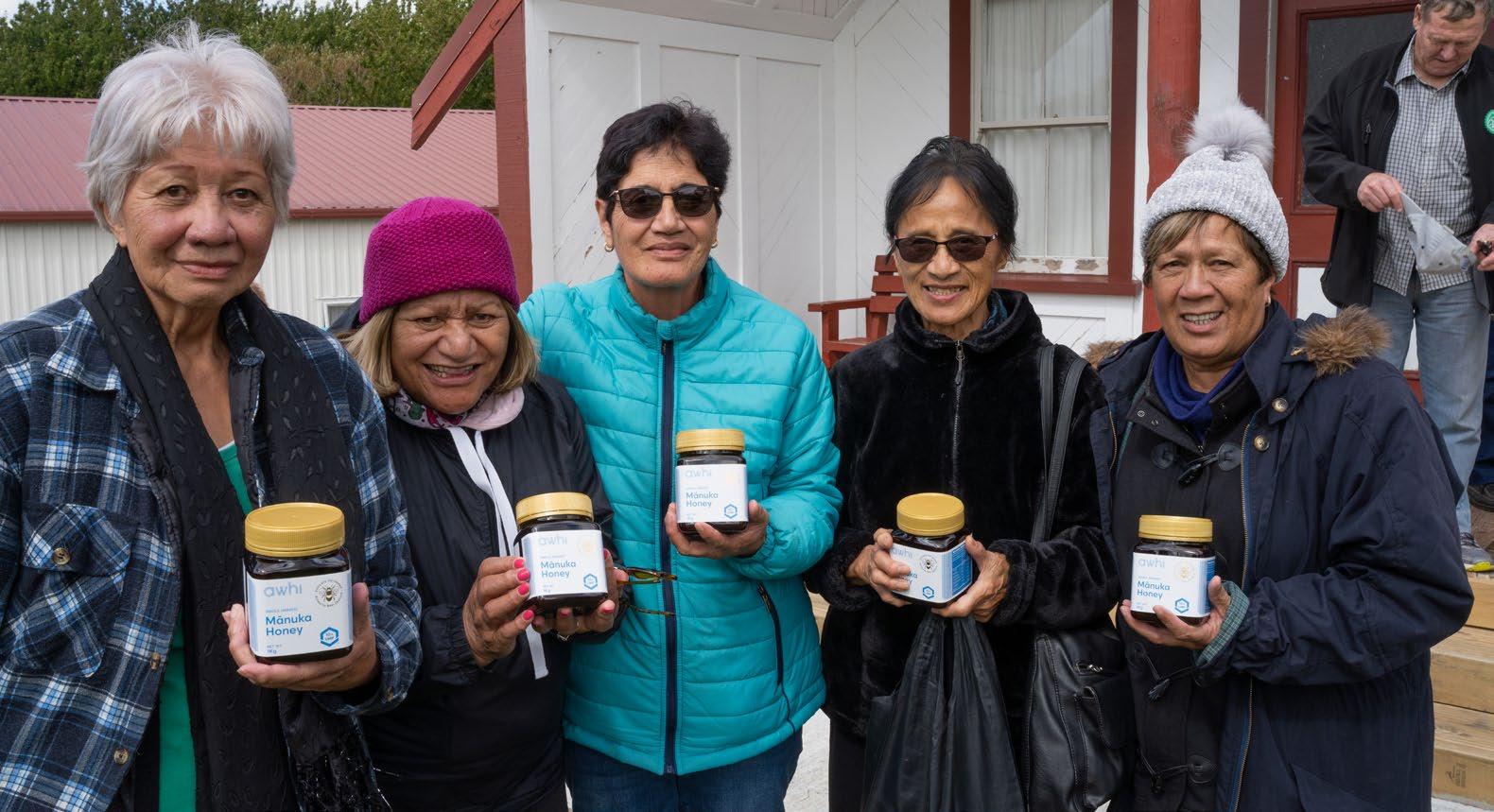 Above left: Shareholder whānau at Hapuawhenua Farm.
Above right: Sweet rewards for shareholders on the annual farm tour.
Left: Hunger for knowledge: Allan Taurerewa.
Above left: Shareholder whānau at Hapuawhenua Farm.
Above right: Sweet rewards for shareholders on the annual farm tour.
Left: Hunger for knowledge: Allan Taurerewa.
“What I have received has nourished me. My journey in the later stages of my life is about being present on my own whenua, acknowledging my kaitiaki role that I must play.”
27 TOITŪ TE WHENUA
Allan Taurerewa
Āti Hau Trust
associate trustee
TUKARIRI DRYDEN
 Te
Te
28 TOITŪ TE TANGATA
Tukariri Dryden is giving back to an organisation that gave to him. The 28-year-old, who has just graduated with a Bachelor degree in Business, Management and Marketing from Waikato University, received education grants from Te Āti Hau Trust to help with studies.
“Those grants helped me through university and so I wanted to take the opportunity to give back to the Trust,” he says.
In November 2021, he was appointed as the Trust’s first associate trustee.
The role is all about succession.
“They wanted to add a position where one of the younger rangatahi could come along to these board meetings and offer their input wherever they can and people like me, who have received grants, could use this opportunity to give back to the Trust.”
Tukariri says he applied to be an Independent Trustee, but wasn’t successful, so the Trust, then led by Shar Amner, created the associate role as a steppingstone and learning position for alumni to support the Trust.
As an associate trustee, Tukariri is treated the same way as any other Trustee. He receives all the information, attends all the meetings and is encouraged to think about projects he may want to spearhead.
The only thing he can’t do is vote, but he can contribute to discussions about matters on the table.
Tukariri has found it interesting to find out, first-hand, how his own incorporation works, the process of grant-making and how a big organisation functions well.
On his father’s side, he’s from Ngāti Rangi and Whanganui iwi and has connections to Raketapauma Marae and Rānana Marae. His mother, from Matakana Island, Tauranga Moana, is of Ngāi Te Rangi and Tainui ā Whiro, Waikato descent.
Tukariri was born in Hamilton, and the family moved to Whanganui when he was about to start high school. He went to Whanganui Collegiate and returned to Hamilton to attend Waikato University in 2013.
That same year, Tukariri was one of four rangatahi chosen to represent Aotearoa at a model United Nations conference in Beijing, China.
Overseas beckoned again, so Tukariri had time off his studies and moved to London, where he worked to save funds to travel. “But Covid put a stop to that. I still managed to tick off 30-plus countries in the space of two years, which was awesome.”
Back in Aotearoa, he finished his studies and, for the past two years, has worked at Te Tumu Paeroa –Office of the Māori Trustee. As a Kaitohutohu Tuarā Taonga (Trust Advisor), Tukariri worked with about 90 different Trusts in Whanganui, Manawatū and Taranaki.
He now has a new job as the Mouri Tūroa contracts manager with Ngā Tāngati Tiaki o Whanganui, the post-settlement entity for the Te Awa Tupua (Whanganui River) settlement.
The role is a Jobs for Nature initiative aiming to enhance, protect, and preserve water quality and biodiversity of the awa and its tributaries. “I’ll be responsible for developing and maintaining relationships between landowners and contractors delivering fencing, planting and pest control.”
This fits with his aspirations, which are grounded in the whenua, tāngata and whānau.
“My father, Kemp Dryden, is the chair of the Raketapauma Marae Trust and has also been involved with Ngāti Rangi iwi – he also used to be the CEO,” he says.
“We would always go back to the marae over holidays or weekends to help out and I suppose that’s where it all started.”
Tukariri Dryden
>>
29 TOITŪ TE TANGATA
“We would always go back to the marae over holidays or weekends to help out and I suppose that’s where it all started.”
The eldest of three brothers, Tukariri says he naturally wanted to follow in his father’s footsteps and work for the iwi and for the people. “But I decided I wanted to go to university first to get the tools and experience needed to do that,” he says.
“I do see myself working with Māori land in some way, and I would like to be able to work for my iwi and iwi interests… just figuring out new ways our iwi can thrive and improve financially but also socially, spiritually, physically and bringing a new generation of thinking behind it.”
Te Āti Hau Trust chair Dr Rāwiri Tinirau says succession planning is hugely important, which is why an associate trustee position was created.
“It’s about building our capacity to prepare our people for governance roles. I think the way that we are trying to grow our leadership, grow experiences for our people and make sure they get a taste of what it’s like to sit at a governance table, I think that’s really important,” says Rāwiri.
There are also two independent trustees – Claire Cilliers and Jonelle Hiroti-Kinane.
An independent trustee is someone who is not already a director of Ātihau-Whanganui Incorporation and submits an expression of interest with a CV and cover letter outlining their skills and why they want to serve on the committee.

“We’re really lucky that we’ve got two fantastic women who hold those roles at the moment.”
Jonelle was a previous employee of the Incorporation, in a role where she focused on shareholder engagement and worked directly on Te Āti Hau Trust priorities and workstreams. She is now working for a government agency.
Claire, who works in the health sector, moved to Aotearoa a few years ago. “She has learnt a lot about our people and te ao Māori through her involvement with the Trust.”
Right: Te Āti Hau Trust's first associate trustee Tukariri Dryden also has a new role as the Mouri Tūroa contracts manager for the Ngā Tāngata Tiaki o Whanganui Jobs for Nature initiative.
“I do see myself working with Māori land in some way, and I would like to be able to work for my iwi and iwi interests…”
30 TOITŪ TE TANGATA
Tukariri Dryden
In good hands
From past to present, Te Āti Hau Trust is in good hands and good health, says new chair Dr. Rāwiri Tinirau.
Other trustees on the new committee are Che Wilson and Dr Tiwha Puketapu (new appointments), Claire Cilliers (independent), Jonelle HirotiKinane (independent) and Tukariri Dryden (associate).
Rāwiri, who was also on the previous Trust committee, pays tribute to former Trust members Shar Amner, Mavis Mullins and Aaron Rice-Edwards (independent).
“We had a great previous Trust committee that was really committed to thinking about ways that we can support our shareholders and our uri and worked toward establishing systems that will be enduring,” Rāwiri says.
Two highlights of the prior committee’s tenure included contracting a project manager to help with Trust plans and moving to online applications for education grants and scholarships, in partnership with the Māori Education Trust.
“Yes, we have had some teething problems, but we had to give it a go,” Rāwiri says. “We live in a time now where information technology is key to helping us in the future.
“We are trying to improve our efficiency and effectiveness as a
Trust, and we think investing in a streamlined online application process for our education grants and scholarships is a great start.”
However, Rāwiri says some grants are unlikely to be offered online, particularly kaumātua grants for health and wellbeing. “Our elderly prefer to provide a manual application, and that’s fine too,” he says.
In recent years, there has been an increase in people applying for kaumātua grants. “One of the moves by the previous Trust was to look at those applications on a monthly basis rather than a quarterly basis, which means we can process them a lot faster as the need arises,” Rāwiri says. Project management was contracted to M & M Ltd – Miriama Cribb and her brother Manahi. They were also asked to look at a process to provide regular grants to the 40plus marae within the rohe.
“We are unable to provide grants to all marae every year, but we’ve started by giving them all a oneoff grant and looking at a cyclable approach, where a marae will be able to receive a grant every three years from the Trust.”
The Trust also plans to continue its marae capital and infrastructure grants for big projects.
“That’s another area where the project manager has been able to lead out on.”
The project manager is also looking at Trust alumni – those people who have received grants, particularly education ones – and thinking of ways to maintain engagement with them beyond the life of their grant or scholarship.
The Trust held a productive strategy workshop in March, but outcomes from that are yet to be released. However, Rāwiri says the committee is looking at how the Trust is aligned to the whole Ātihau Group and what its contribution to the Group could be, while continuing the direction and work of the previous Trust.
“We are trying to improve our efficiency and effectiveness as a Trust, and we think investing in a streamlined online application process for our education grants and scholarships is a great start.”
31 TOITŪ TE TANGATA
Rāwiri Tinirau
Stepping up
Inspiration from his father and a promise to his mother are some of the reasons Rhys Mohi has embarked on a journey to gain a Masters in Māori and Indigenous Leadership.

32 TOITŪ TE TANGATA
Rhys began his study in 2022 with the University of Canterbury while still working at the IRD in Palmerston North, where he lives with his whānau.
“My greatest mentor in life is my pāpā, Douglas Mohi from Te Teko, who now resides in Whanganui with my māmā (Erana) on her papakāinga by Otoko pā – a man passionate about te reo and heavily entrenched in mātauranga Māori, a man who has taught me to never compromise your tikanga.”
Rhys’ father left school at 16 to attend Māori trade school and then had a successful plastering business in Palmerston North. But many people didn’t know the hard-working tradesman was fluent in te reo Māori, which led to his second career. After 22 years as a plasterer, he enrolled in a brandnew programme, Te Atakura, to support people highly proficient in te reo Māori to become teachers of the language.
Once he graduated, Douglas became a teacher of te reo at St Peter’s College, eventually becoming head of the Māori department.
“My greatest mentor in life is my pāpā... a man passionate about te reo and heavily entrenched in mātauranga Māori, a man who has taught me to never compromise your tikanga.”
Of Te Āti Haunui-a-Pāpārangi and Ngāti Rūai on his mother’s side, and Ngāti Awa and the hapū Ngā Maihi on his father’s side, Rhys identifies strongly with the words his dad always says: “Follow the footsteps of your tīpuna.”
While his dad is a fluent speaker of te reo Māori, Rhys is a few steps behind. “I’m on the language journey. I would be an intermediate speaker of the reo, but by no means fully proficient. I’ve really had to take up that challenge.”
That become pivotal when he and his wife, Nuwyne Kiri Te Awe Awe, began a family. Their four children, aged 21, 19, 17 and 15, have all
been immersed in Te Aho Matua and Māori education. “They are all fluent speakers, so I had to lift my game.”
To help with his leadership studies, Rhys received a Te Āti Hau Trust grant, which he has found hugely helpful.“It was amazing. I was able to use those funds directly to support me in my wānanga travels.”
The grant helped pay for petrol needed to drive from Palmerston North to Taranaki, and also helped with koha for marae he stayed on.
IRD has also been supportive of Rhys’ academic journey, allowing him to take time for study and to

>>
Rhys Mohi
Left: Rhys Mohi aims to complete his Masters dissertation by the end of 2024.
33 TOITŪ TE TANGATA
Right: Rhys' parents; Erana and Douglas Mohi.
go away. In the first six months of the programme, Rhys attended six wānanga on different marae, each three days long, as part of the Taranaki cohort led by Che Wilson.

Rhys was driven to do a Masters to help make changes at the IRD and to support iwi, hapū and whānau development.
“In order for me to do that, I needed to build up a better understanding of, in essence, what does tino rangatiratanga mean to me and that’s what prompted me to look at taking on this Masters.”
When he first started studying, his role at IRD was as Kaitakawaenga Māori, supporting Māori customers with their taxes and entitlements.
Now he has a new job at Inland Revenue. “I’m now a Domain Specialist, or Kaitohutohu, with a newly created unit, Te Kāhui Tūhono. There, we are looking to deliver our Māhutonga strategic approach, which integrates Te Tiriti o Waitangi and Māori principles, concepts, and practices into the way we work to support a shift in our organisational culture.
“I’m really excited with my new mahi. We have the opportunity to not only make our organisation a world-class leader in tax administration but also a worldclass leader in indigenous cooperation.”
Flowing on from his work at the IRD, Rhys says the study has already
“It’s enabled me to be staunch in my principles that have been passed on to me by both my father and mum – to be unapologetic about things relevant to Māori and being Māori.”
Rhys Mohi
had an impact on him. “It’s enabled me to be staunch in my principles that have been passed on to me by both my father and mum – to be unapologetic about things relevant to Māori and being Māori.”
To gain his Masters, Rhys needs to complete six papers and a thesis, which he aims to finish by the end of 2024.
“There have been a lot of overnight weekends and finishing at five in the morning to complete my assignments.”
When Rhys does finish, he’ll honour his mother’s wishes.
“I gave her a promise that after studies I would be looking to put my hand up as a trustee and work on the marae committee. Those are my immediate goals. Just seeing the tireless work that my parents contribute to the marae, it will be nice to help them with that and their legacy.”
34 TOITŪ TE TANGATA
Left to right: Erana Mohi, Nuwyne Kiri Te Awe Awe, Aareta Mohi (Rhys and Nuwyne's eldest daughter), Rhys and Douglas Mohi at Otoko Pā.
“I gave her a promise that after studies I would be looking to put my hand up as a trustee and work on the marae committee. Those are my immediate goals. Just seeing the tireless work that my parents contribute to the marae, it will be nice to help them with that and their legacy.”

35 TOITŪ TE TANGATA
Rhys Mohi
ATIHAU-WHANGANUI INCORPORATION Toi tu te whenua PO Box 4035 Whanganui 4541 New Zealand © ĀTIHAU-WHANGANUI INCORPORATION 2023
















 Dr Tiwha Puketapu
Dr Tiwha Puketapu
 Jason Ashford
Te Ātihaunui-ā-Pāpārangi, Te Arawa, Ngāti Tūwharetoa
Jason Ashford
Te Ātihaunui-ā-Pāpārangi, Te Arawa, Ngāti Tūwharetoa














 Left: Board member and Tai-o-Rongo research principle Che Wilson reveals kōrero tuku iho about an ancient stargazing site at Tohunga Station.
Left: Board member and Tai-o-Rongo research principle Che Wilson reveals kōrero tuku iho about an ancient stargazing site at Tohunga Station.
















 Above left: Shareholder whānau at Hapuawhenua Farm.
Above right: Sweet rewards for shareholders on the annual farm tour.
Left: Hunger for knowledge: Allan Taurerewa.
Above left: Shareholder whānau at Hapuawhenua Farm.
Above right: Sweet rewards for shareholders on the annual farm tour.
Left: Hunger for knowledge: Allan Taurerewa.
 Te
Te














